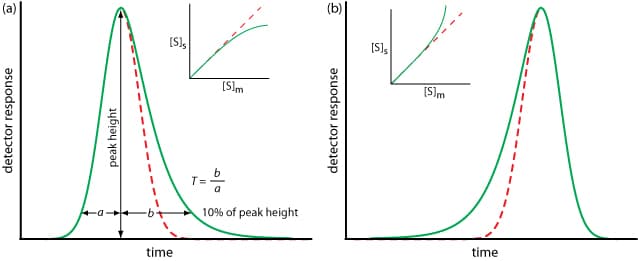Chromatography is a highly effective means of testing samples for different components and elements. But what happens when the results are not quite as you expected?
Take a look at our guide to understanding the different peaks on a chromatogram, and to troubleshooting any problems you might encounter.
Peak Fronting
When you are examining the results from your chromatography, you are hoping for well-defined peaks that are easy to read, and also symmetrical. This means that you know exactly what kind of material you are dealing with, and can plan how this material will be handled accordingly. However, this might not always be the case. You may find yourself with some peaks that are wider in the front half than they are in the back. This creates an asymmetrical effect known as fronting.
The main cause of this is usually poor solubility of the sample – i.e., the sample cannot be evenly dissolved into the solution for examination. To tackle this, either reduce the volume of the sample being experimented on or reduce the concentration of the solute.
Peak Tailing
Tailing is basically the inverse of fronting. The peak is presented asymmetrically, with a broader second half and a narrower first half – breaking away from the ideal peak shape, with its symmetrical Gaussian profile.
While the effect is similar, the circumstances of tailing are different from those of fronting. Usually, the sample is simply too large, and is causing uneven levels of retention at different points during the experiment. Reducing the sample amount should counteract this.
There may also be secondary interactions taking place, distorting the peak shape. Injecting a neutral compound into the sample solution should even this out.
Peak Ghosting
Ghost peaks refer to the residual images of peaks that appear during an experiment but are unrelated to the experiment itself.
For example, maybe your original hypothesis predicts that you will see A, B, and C peaks in your final results. These peaks are present and correct, but there are others also – others that you did not predict. Some of these peaks overlap with the expected results, causing confusion, and you cannot find a reason for these anomalies.
This may be the result of ghosting. This may occur when the delivery equipment has not been properly cleaned after the last experiment, or if the sample has become otherwise contaminated. The only way to effectively deal with this is to start again with a fresh sample, being careful to eliminate any potential contamination, and to thoroughly clean all equipment.
Rounded Peaks
We have already discussed how, in order to get a solid set of result, chromatogram peaks need to be well-defined. This makes sense as you need precise measurements, and this is impossible if the peak does not have a sharp point at its crest.
When there is no sharp point, the peak becomes rounded. Blockages in the column inlet can lead to this issue, and you may need to repack the column to make sure the flow is even.
The peak may also become split, or may develop a shoulder that further obscures the results. This may also be caused by a blockage.
There may also be damage to the equipment at the point of inlet. Take time to examine the equipment and consider a replacement.
Want to learn more about sample testing equipment and solutions? Reach out to our team today.
